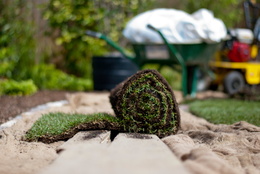Landscape fabrics are used to get rid of weeds and can be installed easily without any hassle.

I am sure most people who have wide expanses of land, dream of turning it into a beautiful landscape. It is a nice thought but there are a few steps that need to be taken in order to turn it into a reality. Keeping weeds at bay and allowing the plants to grow, is certainly an important step. With that thought in mind, here are some information about landscape fabrics.
Landscape fabric is basically a material that is placed around flowers, shrubs, and trees. The use of this material is to promote plant growth and stop weeds. This material blocks out sunlight so that weeds cannot grow. The plants do not suffer because it is permeable and moisture and air can reach the plant.
There are a few factors that need to be taken into consideration when selecting landscape fabric, here they are:
- Select a fabric that is strong enough to hold out to the vigorous stresses of application.
- It must be porous enough to allow water and air to pass freely to the soil. This is an important feature to be taken into consideration because if the fabric does not breathe properly then the soil may become sour and sterile.
- The fabric should have a consistent and even distribution of fibers. Apart from that, the openings in it should be small enough to prevent weedy grasses from coming up through the fabric.
The installation of landscape fabric can be divided into a number of steps. The steps have been enumerated below:
- Firstly, it is important to ensure that the soil is completely free of weeds. You can eliminate them using two methods. One is by repeated cultivation and secondly by applying a herbicide.
- Secondly, select a calm day to proceed with the installation.
- Once you have selected an appropriate day, unroll the fabric and estimate where to cut it.
- Using a sharp knife or a pair of scissors, cut slits and then carefully cover the fabric over and around the plant.
- To close any gaps overlap the seams by at least 3 inches.
- Use nails, heavy wire staples, or plastic pegs to anchor the outer edges of the landscape fabric.
After Installation
Once the landscape fabric has been installed, cover the fabric entirely with 20-30 inches of weed-free organic mulch such as shredded bark. This is done to protect the fabric from ultraviolet degradation and helps conserve moisture too. Once that is done, feed the plants using liquid fertilizer.
So, if you have spare land, and the only thing that is stopping you from using it for gardening is the threat of weeds, using landscape fabrics is a good option for you. With a little bit of effort, you would be able to utilize your land in the right manner.






 I am sure most people who have wide expanses of land, dream of turning it into a beautiful landscape. It is a nice thought but there are a few steps that need to be taken in order to turn it into a reality. Keeping weeds at bay and allowing the plants to grow, is certainly an important step. With that thought in mind, here are some information about landscape fabrics.
I am sure most people who have wide expanses of land, dream of turning it into a beautiful landscape. It is a nice thought but there are a few steps that need to be taken in order to turn it into a reality. Keeping weeds at bay and allowing the plants to grow, is certainly an important step. With that thought in mind, here are some information about landscape fabrics.